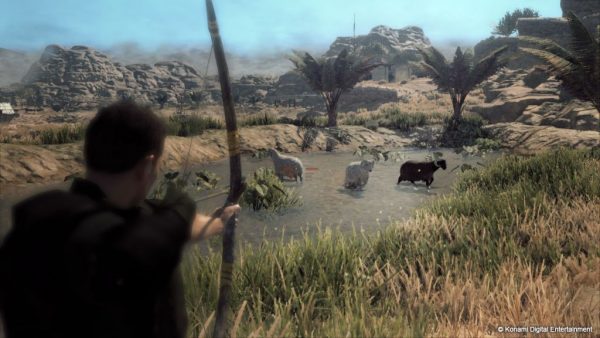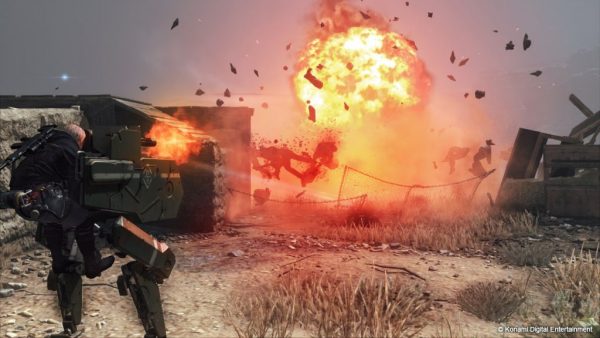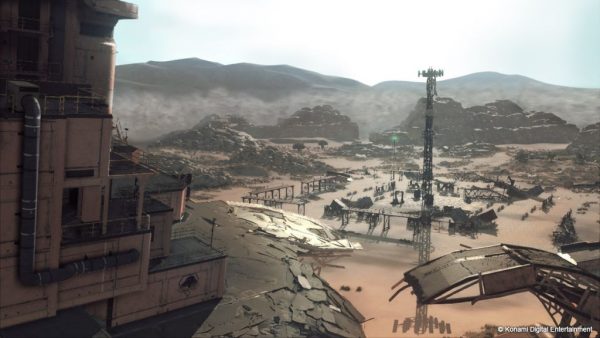Also On: Xbox One, PC
Publisher: Konami
Developer: Konami
Medium: Blu-ray/Digital
Players: 1-4
Online: Yes
ESRB: M
Metal Gear Survive is the first post-Kojima thing to carry the Metal Gear name for publisher Konami, and it doesn?t exactly feel like Konami is putting their best foot forward with this effort. It?s a weird amalgamation of the look and feel of The Phantom Pain combined with some run-of-the-mill survival game mechanics that are better represented in many other like-minded games. Metal Gear Survive isn?t a complete wash, there were definitely moments where I was able to gleam some enjoyment out of the game, but I think you?ll find that those moments are fleeting at best.
The opening moments of Metal Gear Survival set-up the game as a alternate history version of events pulled from Metal Gear Solid V, where you play the role of a soldier in Big Boss? unit that gets sucked into a wormhole, the same technology used for fulton devices in later upgrade stages of The Phantom Pain. The wormhole takes you to an another realm, ravaged by a mysterious virus, which has the nasty habit of turning humans into Wanderers, the Metal Gear equivalent of zombies.
 There?s a bit more to all of this than meets the eye of course, but I won?t spoil the story here since it?s one of only a few compelling reasons to check out Metal Gear Survive. That said, don?t expect any shattering revelations or significant ties into Metal Gear lore. Survive feels very much like a non-canonical side story that incorporates terms and mechanics familiar to Metal Gear fans, without actually making any significant impact on the series as a whole.
There?s a bit more to all of this than meets the eye of course, but I won?t spoil the story here since it?s one of only a few compelling reasons to check out Metal Gear Survive. That said, don?t expect any shattering revelations or significant ties into Metal Gear lore. Survive feels very much like a non-canonical side story that incorporates terms and mechanics familiar to Metal Gear fans, without actually making any significant impact on the series as a whole.
The core gameplay of Metal Gear Survive revolves almost entirely around the single-player mode. There?s an online co-op mode which consists of fending off waves of enemies throughout various missions that generally differentiate themselves by setting, difficulty, and side missions. It?s not a particularly noteworthy addition to the game, and can feel pretty unbalanced for players that are just starting out. That said, it does serve as a considerable way to gain resources early on, so despite not being able to carry your own weight at early levels, there is some draw to diving into the online mechanics early on.
 For the single-player side, you?ll primarily be tasked with building up your home base as you progress through the story. Doing so will require you to venture out into the wild, including hazardous Dust zones that contain toxic air. The further away from base you venture, the more difficult the game tends to get. Along the way you?ll need to manage a number of typical survival game stats, like thirst, hunger, stamina, health, and oxygen. Most of these are bolstered via food and water, which you?ll scavenge throughout the map. These meters can deplete pretty quickly too, which means you?ll spend a good chunk of time just revisiting watering holes and spots on the map where you?ve seen animal life before.
For the single-player side, you?ll primarily be tasked with building up your home base as you progress through the story. Doing so will require you to venture out into the wild, including hazardous Dust zones that contain toxic air. The further away from base you venture, the more difficult the game tends to get. Along the way you?ll need to manage a number of typical survival game stats, like thirst, hunger, stamina, health, and oxygen. Most of these are bolstered via food and water, which you?ll scavenge throughout the map. These meters can deplete pretty quickly too, which means you?ll spend a good chunk of time just revisiting watering holes and spots on the map where you?ve seen animal life before.
As you explore and gather resources, you?ll also uncover blueprints that allow you to build new equipment, weapons, and base improvements. You?ll also eventually encounter other survivors, and the base personnel management that was featured in The Phantom Pain returns here. You?ll also occasionally be tasked with defending your base, or defending against waves of enemies on other points of the maps as you secure teleporters and other waypoints.
 Combat early on is primarily melee based. It never feels particularly great and satisfying, with one of your early tactics consisting of literally placing a fence in front of you, letting zombies run up against it, and stabbing away at them between the links for some risk-free kills. Most encounters are actually manageable. The zombies can lunge quickly, but it is relatively easy to pick out the tells and timing, so you can quickly get behind them for a ?stealth? kill to take them down without much effort. Even tougher enemies later in the game are susceptible to the same tactic, and if you get swarmed it?s honestly not that hard to outrun anything. Ranged combat does come into play, you?ll gain access to both guns and bows, but surprisingly you?ll find that melee combat tends to be the most effective way of dealing with most foes.
Combat early on is primarily melee based. It never feels particularly great and satisfying, with one of your early tactics consisting of literally placing a fence in front of you, letting zombies run up against it, and stabbing away at them between the links for some risk-free kills. Most encounters are actually manageable. The zombies can lunge quickly, but it is relatively easy to pick out the tells and timing, so you can quickly get behind them for a ?stealth? kill to take them down without much effort. Even tougher enemies later in the game are susceptible to the same tactic, and if you get swarmed it?s honestly not that hard to outrun anything. Ranged combat does come into play, you?ll gain access to both guns and bows, but surprisingly you?ll find that melee combat tends to be the most effective way of dealing with most foes.
My general complaints against Metal Gear Survive consist of two things. One, the combat is sort of a bore. Enemies are rarely challenging, they?re not varied enough, and the only time I felt at risk was during indoor sequences, only because the camera was generally not great. The second issue is that the actual survival mechanics are pretty basic. You can build up your base, but the customization options are truly limited. I can?t create wild structures, multileveled abodes, or any other weird living quarters. Crafting is limited to the schematics you find while exploring, and it feels abnormally long to acquire basic things like the ability to filter drinkable water. And the inability to just break down a number of structures you find out in the field for resources can be limiting, especially when you?re resource starved early on.
I can?t really suggest Metal Gear Survive to either Metal Gear fans or survival game fans. There are better options out there for both, and Metal Gear Survive provides little incentive. I can appreciate the idea of trying to make a Metal Gear sidestory work, but this is an abysmal first effort by Konami, and really adds another layer of tarnish to the whole Kojima exit. It?s probably for the best that the Metal Gear brand take a good, long break, as Konami clearly needs to figure out better options for the series going forward.
Note: Konami provided us with a Metal Gear Survive PS4 code for review purposes.


